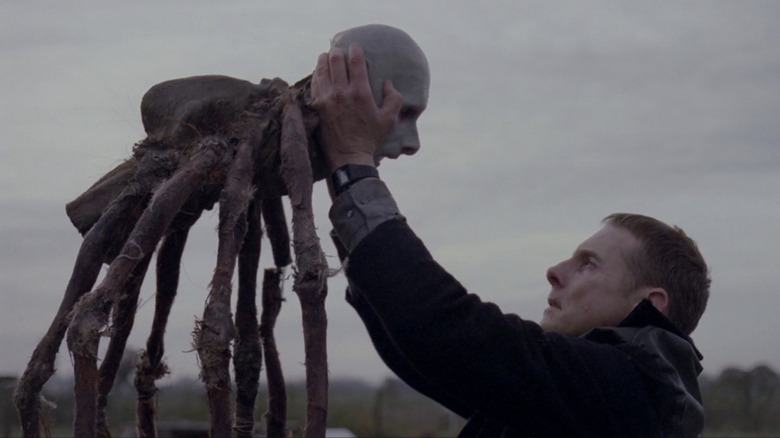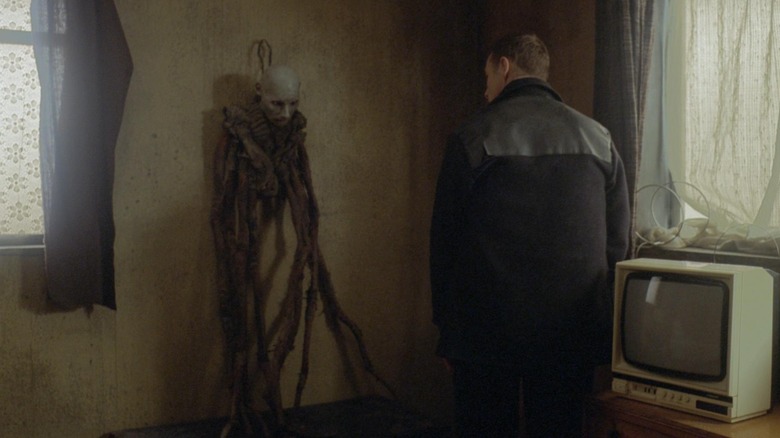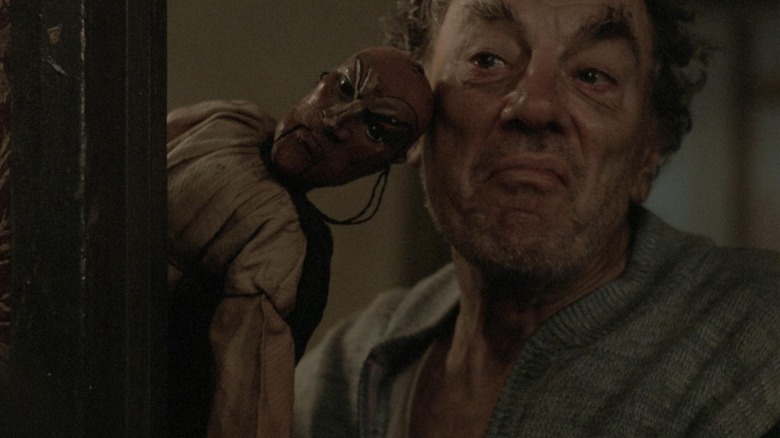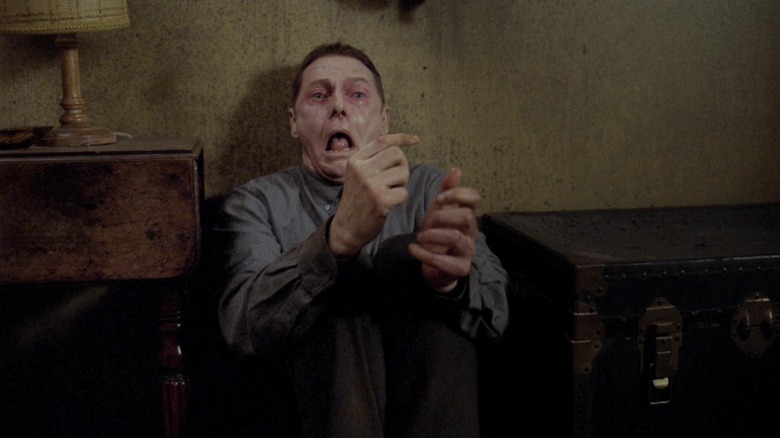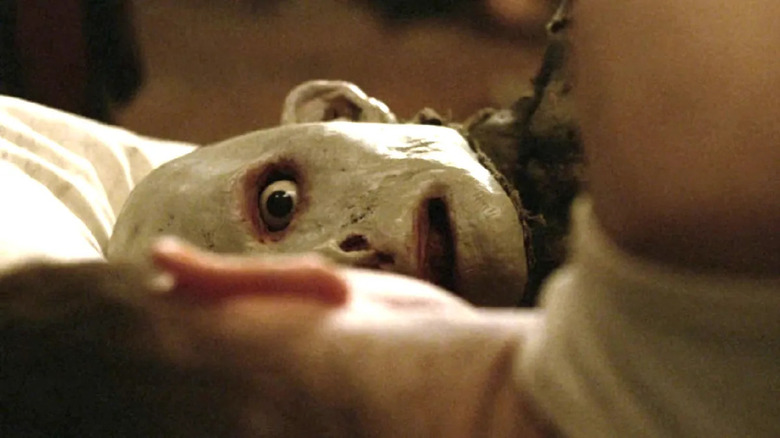Possum Ending Explained: Master Of Puppets
Warning: This article discusses difficult subject matter including sexual assault and child abuse.
I first learned about Matthew Holness' "Possum" when it was seeking distribution during the American Film Market. Hundreds of titles were on display, but everyone was talking about a black and white poster of a bed with a bag on it ... but the bag and gigantic spider legs sticking out of it. The image sparked a visceral reaction from anyone who walked by, but few could have predicted the abject terror that would come with "Possum." The closest genre to define "Possum" is a psychological thriller, but it's filled with jarring imagery, effective jump scares, and a story that crawls under your skin — and stays there.
"Possum" is based on Holness' short story of the same name featured in "The New Uncanny: Tales of Unease," and incorporates Sigmund Freud's theories on the uncanny. Utilizing a filmmaking style reminiscent of old British public information films (PSAs, for my fellow Americans), German expressionist films, the British anthology "Dead of Night," and "Martin" by George A. Romero, "Possum" centers on a man named Philip (Sean Harris), a disgraced children's puppeteer who is forced to reckon with his past trauma after returning to his family home and coming face to face once again with the uncle who raised him following the death of his parents.
Philip spends most of the film either enduring or trying to stave off a mental breakdown, accompanied by a puppet named Possum, a spider-like marionette with Philip's face and legs that extend to the point of making it the height of a human. "Possum" plays out like a depressing fever dream, which makes the ending of the film a difficult one to process — especially if you've had an experience anything like Philip's childhood.
What you need to remember about the plot of Possum
Philip reluctantly returns to his family home, which is still in disarray following a past fire. His uncle Maurice (Alun Armstrong) still lives there and is a derelict man whose presence triggers Philip at every turn. As if things weren't bad enough, Philip is haunted by his puppet Possum, who he keeps stored away in a duffel bag. He tries to get rid of it, but it returns again and again. While at the house, he uncovers a picture book he made as a child, which includes the lore of the Possum consuming orphaned children while they sleep in their beds. It seems he created Possum as a tangible allegory for his own trauma.
There's a closed-off room in the house that Maurice taunts Philip about entering, and constantly reopens his emotional wounds from childhood. He demands Philip recount traumatic situations, reveling in his pain. In the middle of it all, a young boy in town named Michael goes missing, and the suspected person of interest fits Philip's description. In discussing the situation with Maurice, he again taunts Philip, mentioning that when he was a child, there was a similar case of a boy being assaulted by a masked man.
Are these situations all connected?
What happened at the end of Possum?
Philip tries to solve the mystery of the missing boy but is continually haunted by visions of Possum. As a last-ditch effort, he finally thinks to check behind the door he has been avoiding for much of the film. The room on the other side is his parents' bedroom, still charred from the fire that took their lives. It looks exactly as it did the last time Philip saw it, but he discovers a jar containing pulled teeth. Someone has been using this room for a long, long time. Suddenly, a hooded figure attacks him ... and it's Maurice. He is the one who kidnapped the boy, and he intends to sexually abuse him ... the same way he used to abuse Philip as a child. At first, Philip submits, regressing to the same victimized mindset he had as a child. He feels helpless, and it's truly heartbreaking to watch this grown man give up and disassociate in the hopes that it will be quick and painless.
He's always known that Maurice was the masked man who abused him, but he never told anyone. This reveal isn't for Philip, it's to confirm the suspicions of the viewers at home. As Maurice taunts him, Philip hears a noise from a trunk in the room, realizing that the missing boy is alive and trapped within. Philip's desire to save this boy's life snaps him out of his regressed mindset, and he overpowers Maurice. He uses broken floorboards to snap his neck, killing him. Without saying anything, he frees the boy who runs to safety. Philip does not follow. He instead sits outside the house, looking out into the distance, with Possum's dismembered head in his lap as the spider legs sit in the trash heap.
What the end of the Possum means
"Possum" is a film that uses horror elements as metaphorical storytelling, personifying lifelong trauma into a tangible monster. The Possum puppet was representative of how Philip felt about his abuse, and the reason he couldn't "get rid" of the Possum was because he had been running from his trauma rather than facing it. Possum being a marionette means that it is a reflection of the puppeteer's actions, whether Philip was conscious of it or not. When he finally calls out Maurice for who is really is and what he's done, he's metaphorically cutting the strings of his Possom. He strokes the head of the puppet, resembling his own face, as a means of nurturing and healing. He's showing affection to the face, self-soothing made tangible.
At the same time, Maurice has been acting as the puppeteer of Philip for many years, reflected in the spindly legs of Possum. In a way, the monstrous appearance of Possum could be viewed as inherited, generational trauma. The beheading of Possum reflects the snapping of Maurice's neck — symbolizing Philip's separation from Maurice's power. The final moment is a reflection of three relationships altering in a flash; Maurice to Philip, Philip to Possum, and Philip to himself.
Or, there's the off-chance that everything we're seeing is just a manifestation of Philip's trauma and none of it was real. The film never takes a hard stance, and it's up to the viewer to decide.
What has the cast and crew of Possum said about the ending?
Filmmaker Matthew Holness is known in the U.K. primarily for comedy, like the cult-hit "Garth Marenghi's Dark Place," which also features fan-favorite "What We Do In The Shadows" star, Matt Berry. The best comedies are rooted in relatable situations at their center, as are the very best horror films. Holness took this approach with "Possum," using horror as a vehicle to address serious topics. In an interview with Newsweek, he explained that horror is a great medium to capture subjective experiences like psychological trauma because it impacts us all in unique ways. "If we are going to deal with these monsters in any way, why not the horror film? That is true horror," he said. This puts fictional monsters in the same camp as realistic depictions of real-life trauma, because one is often serving as a metaphor for the other.
Holness recognized the power of metaphor and allowed the ambiguous ending to speak for itself. This allows the viewer to interpret the film in whatever way is best for their perception. As he told Pop Matters, "With something like 'Possum,' what we are seeing is the world as Philip sees it, so it would cease to be the film that it is if you followed the logical world and path of events." Going a step further, he told Newsweek, "There are questions that are deliberately placed in front of the viewer, [and] the answers to these questions are things that other films would consider essential details, but that's not the case here, and the ending deliberately neglects to clear things up."
So if you're hoping for a definitive "this is what the film is about" answer, Holness isn't going to provide it. Sometimes the best way to grow is to allow yourself to sit in discomfort, and that's what "Possum" is truly about.
